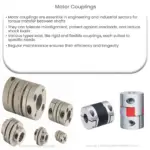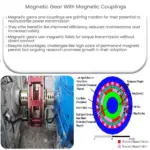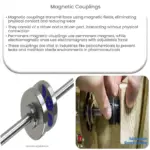Magnetic coupling transfers mechanical energy or torque between components through interacting magnetic fields without physical contact.
Understanding Magnetic Coupling
Magnetic coupling is a non-contact method of transferring mechanical energy or torque between two components. This technology has various applications in industries like robotics, aerospace, and automotive systems. In this article, we’ll explore the principles behind magnetic coupling and its advantages over conventional mechanical couplings.
Principles of Magnetic Coupling
Magnetic coupling is based on the interaction between magnetic fields produced by permanent magnets or electromagnets in the two components. These fields can attract or repel each other, creating a force that allows the transmission of mechanical energy without physical contact. The fundamental principles involved in magnetic coupling are:
- Magnetic field interaction: Two magnetic fields in close proximity will interact with each other, resulting in a force that can either attract or repel the magnets.
- Field orientation: The orientation of the magnetic fields is crucial for efficient coupling. Proper alignment ensures maximum torque transfer and minimal energy loss.
- Magnetic materials: The choice of magnetic material greatly influences the coupling efficiency. Materials with high magnetic permeability and low coercivity are preferred for optimum performance.
Types of Magnetic Coupling
There are two primary types of magnetic coupling:
- Permanent magnet coupling: This type of coupling uses permanent magnets to create the magnetic fields. The magnets are arranged in a specific pattern on both the driving and driven components, ensuring proper alignment of the magnetic fields.
- Electromagnetic coupling: In this type, the magnetic fields are generated by electromagnets. The advantage of using electromagnets is that the magnetic force can be controlled by adjusting the current, enabling variable torque transmission and precise control.
Advantages of Magnetic Coupling
Magnetic coupling offers several benefits over conventional mechanical couplings, such as:
- No physical contact: Since there is no direct contact between the components, wear and tear are significantly reduced, leading to longer service life and lower maintenance costs.
- High torque transmission: Magnetic couplings can transmit high torques, making them suitable for various industrial applications.
- Controlled slip: Magnetic couplings can be designed to allow controlled slip, which is useful in overload protection and torque limiting.
- Reduced vibration and noise: The absence of mechanical contact reduces vibration and noise, resulting in a smoother and quieter operation.
In conclusion, magnetic coupling is an innovative technology that offers numerous advantages over traditional mechanical couplings. Its non-contact nature results in increased efficiency, reduced maintenance, and enhanced performance across various applications.




